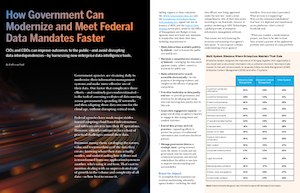- Sponsored
- Modernization
How federal agencies can improve data insights and lower storage costs

Federal agencies can improve how they share data with the public and avoid disrupting data interdependencies as they modernize their IT systems with the help of new enterprise data intelligence tools, according to specialists in a new report.
Modern data intelligence tools are becoming more important as agencies prepare to meet new federal data management mandates. Even though most agencies understand how insights from data can fuel efficiency and effectiveness, far fewer understand how to harness data to better serve the mission, say experts in a new report on data management technology produced by FedScoop and underwritten by ASG Technologies.

Read the full report.
Today’s modern enterprise data intelligence platforms give chief information officers (CIOs) and chief data officers (CDOs) greater visibility into, and control over both structured and unstructured data their agency has in various systems. That includes understanding where that data resides — both on-prem or in multiple clouds — and how it is used, the report says. The key benefit of advanced enterprise data intelligence tools for agency leaders, the report concludes, is that it gives decision makers a more holistic view of strategically important data to improve mission outcomes.
At the same time, the tool enhances the IT department’s ability to reduce risks of disrupting daily data flows as they modernize their IT systems.
Federal requirements for data management and storage
New federal mandates are pushing CDOs and other agency leaders to meet stricter standards for data management and sharing — including the OPEN Government Data Act and the Foundations of Evidence-Based Policymaking Act, signed into law in January 2019, and the Federal Data Strategy action plan, issued by the Office of Management and Budget in December. These mandates strengthen government policy on records accessibility, data privacy and risk practices and prescribe new rules for managing data as strategic assets, among other things.
To meet the requirements and continue modernizing coherently, agency leaders need a more comprehensive view of their data estate, according to Ian Rowlands, director of product marketing at ASG Technologies. That means not only knowing the structure and meaning of an agency’s data assets, but also having a deeper understanding of an agency’s data flow.
“How your data is processed. What services is it supporting? Who are the interested stakeholders? And how is it deployed and transformed across platforms — that’s critical,” says Rowland.
Benefits of an enterprise data intelligence tool
The mandates require agencies to better manage risk and reduce the redundancy of data storage, but to get there, agencies will need capabilities that help them understand where critical data resides, says Wayne Monk, ASG Technologies’ senior vice president of global alliances and channel sales.
“From source to consumption, [agencies need to] map how the data travels, to clearly see what dependencies your data has prior to any modernization efforts,” Monk explained.
He shared how one of ASG’s enterprise customers recently benefited from consolidating its view of its data with the help of an enterprise data intelligence tool. Before implementing ASG’s Data Intelligence solution, the customer estimated it had likely stored taxpayer ID information in 20 or more locations across its systems. However, once they mapped out their data, officials discovered that information was actually being stored in 230 different locations.
The exercise enabled leaders to reduce that number to 12 storage locations, thereby reducing a slew of storage, backup resources and other costs while simultaneously improving data quality and trust.
Knowing what to do with structured and unstructured data
According to a study cited in the report, while most organizations have tools to manage structured data, only about 1 in 4 large organizations across a range of industries report having formal, enterprisewide content management systems for unstructured data assets such as documents, videos and images in many different file formats.
Experts in the report share how both structured and unstructured data play a critical role in transforming today’s enterprises. First there’s the effectiveness and efficiency of data to the organization’s mission objectives. Second, there’s the value using the data creates when implementing services.
Because of the growing volume of data moving to, or being pulled from, applications outside their traditional repositories and content systems, there is a greater need for enterprise tools that can bridge the divide between structured and unstructured data sets.
“Having the right enterprise data intelligence tools in place can give agencies a powerful leg up in being able to define, manage and track workflows through reports and dashboards to help collaboration teams understand where issues have arisen and how they were being addressed,” according to Rob Perry, ASG Technologies’ vice president of product marketing.
But perhaps more importantly, the tool also gives agency leaders a crucial platform to “properly involve multiple stakeholders in the governance of those projects,” he said.
Read more about how government agencies can modernize and meet federal data mandates faster with enterprise data intelligence tools.






